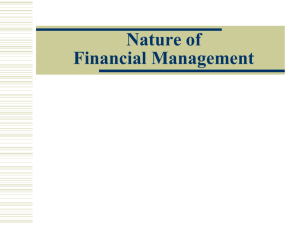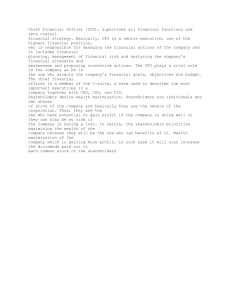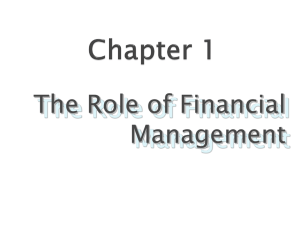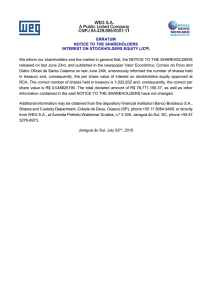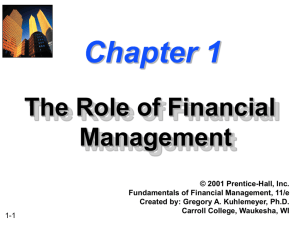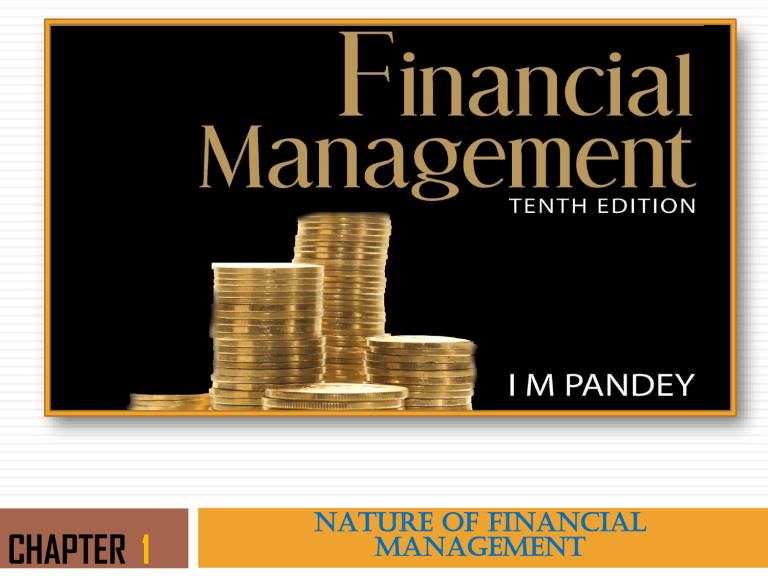
CHAPTER 1 NATURE OF FINANCIAL MANAGEMENT LEARNING OBJECTIVES 2 Explain the nature of finance and its interaction with other management functions Review the changing role of the finance manager and his/her position in the management hierarchy Focus on the Shareholders’ Wealth Maximization (SWM) principle as an operationally desirable finance decision criterion Discuss agency problems arising from the relationship between shareholders and managers Illustrate the organization of finance function Important Business Activities 3 Production Marketing Finance Real And Financial Assets 4 Real Assets: Can be Tangible or Intangible Tangible real assets are physical assets that include plant, machinery, office, factory, furniture and building. Intangible real assets include technical know-how, technological collaborations, patents and copyrights. Financial Assets are also called securities, are financial papers or instruments such as shares and bonds or debentures. Equity and Borrowed Funds 5 Shares represent ownership rights of their holders. Shareholders are owners of the company. Shares can of two types: Equity Shares Preference Shares Loans, Bonds or Debts: represent liability of the firm towards outsiders. Lenders are not owners of the company. These provide interest tax shield. Equity and Preference Shares 6 Equity Shares are also known as ordinary shares. Do not have fixed rate of dividend. There is no legal obligation to pay dividends to equity shareholders. Preference Shares have preference for dividend payment over ordinary shareholders. They get fixed rate of dividends. They also have preference of repayment at the time of liquidation. Finance and Management Functions 7 All business activities involve acquisition and use of funds. Finance function makes money available to meet the costs of production and marketing operations. Financial policies are devised to fit production and marketing decisions of a firm in practice. Finance Functions 8 Finance functions or decisions can be divided as follows Long-term financial decisions • • • Long-term asset-mix or investment decision or capital budgeting decisions. Capital-mix or financing decision or capital structure and leverage decisions. Profit allocation or dividend decision Short-term financial decisions • Short-term asset-mix or liquidity decision or working capital management. Financial Procedures and Systems 9 For effective finance function some routine functions have to be performed. Some of these are: Supervision receipts and payments and safeguarding of cash balances Custody and safeguarding of securities, insurance policies and other valuable papers Taking care of the mechanical details of new outside financing Record keeping and reporting Finance Manager’s Role 10 Raising of Funds Allocation of Funds Profit Planning Understanding Capital Markets Financial Goals 11 Profit maximization (profit after tax) Maximizing earnings per share Wealth maximization Profit Maximization 12 Maximizing the rupee income of firm Resources are efficiently utilized Appropriate measure of firm performance Serves interest of society also Objections to Profit Maximization 13 It is Vague It Ignores the Timing of Returns It Ignores Risk Assumes Perfect Competition In new business environment profit maximization is regarded as Unrealistic Difficult Inappropriate Immoral Maximizing Profit after Taxes or EPS 14 Maximising PAT or EPS does not maximise the economic welfare of the owners. Ignores timing and risk of the expected benefit Market value is not a function of EPS. Maximizing EPS implies that the firm should make no dividend payment so long as funds can be invested at positive rate of return—such a policy may not always work. Shareholders’ Wealth Maximization 15 Maximizes the net present value of a course of action to shareholders. Accounts for the timing and risk of the expected benefits. Benefits are measured in terms of cash flows. Fundamental objective—maximize the market value of the firm’s shares. Need for a Valuation Approach 16 SWM requires a valuation model. The financial manager must know, How much should a particular share be worth? Upon what factor or factors should its value depend? Risk-return Trade-off 17 Financial decisions of the firm are guided by the risk-return trade-off. The return and risk relationship: Return = Risk-free rate + Risk premium Risk-free rate is a compensation for time and risk premium for risk. Risk Return Trade-off 18 Risk and expected return move in tandem; the greater the risk, the greater the expected return. Overview of Financial Management 19 Agency Problems: Managers Versus Shareholders’ Goals 20 There is a Principal Agent relationship between managers and shareholders. In theory, Managers should act in the best interests of shareholders. In practice, managers may maximise their own wealth (in the form of high salaries and perks) at the cost of shareholders. Agency Problems: Managers Versus Shareholders’ Goals 21 Managers may perceive their role as reconciling conflicting objectives of stakeholders. This stakeholders’ view of managers’ role may compromise with the objective of SWM. Managers may avoid taking high investment and financing risks that may otherwise be needed to maximize shareholders’ wealth. Such “satisfying” behaviour of managers will frustrate the objective of SWM as a normative guide. This conflict is known as Agency problem and it results into Agency costs. Agency Costs 22 Agency costs include the less than optimum share value for shareholders and costs incurred by them to monitor the actions of managers and control their behaviour. Financial Goals and Firm’s Mission and Objectives 23 Firms’ primary objective is maximizing the welfare of owners, but, in operational terms, they focus on the satisfaction of its customers through the production of goods and services needed by them. Firms state their vision, mission and values in broad terms. Wealth maximization is more appropriately a decision criterion, rather than an objective or a goal. Goals or objectives are missions or basic purposes of a firm’s existence. Financial Goals and Firm’s Mission and Objectives 24 shareholders’ wealth maximization is the secondlevel criterion ensuring that the decision meets the minimum standard of the economic performance. In the final decision-making, the judgement of management plays the crucial role. The wealth maximization criterion would simply indicate whether an action is economically viable or not. The Organisation of the Finance Functions 25 Reason for placing the finance functions in the hands of top management Financial decisions are crucial for the survival of the firm. The financial actions determine solvency of the firm Centralisation of the finance functions can result in a number of economies to the firm. Organisation of Finance Function 26 Organization for finance function Organization for finance function in a multidivisional company Status and Duties of Finance Executives 27 The exact organisation structure for financial management will differ across firms. The financial officer may be known as the financial manager in some organisations, while in others as the vice-president of finance or the director of finance or the financial controller. Role of Treasurer and Controller 28 Two officers—the treasurer and the controller— may be appointed under the direct supervision of CFO to assist him or her. The treasurer’s function is to raise and manage company funds while the controller oversees whether funds are correctly applied.

